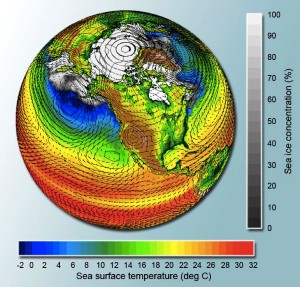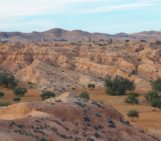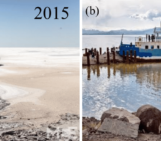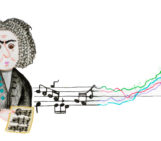Climate and its effects on the past, present and future of the human race is a heated, topic of debate these days. There are many competing interests at stake from governments and politicians to the big oil and energy companies of the world to the scientists trying to work on climate change problems to the people of the world most acutely affected by these changes on the Earth we live. Thus, I think it is extremely important that everyone works together in this day and age to bring together what each individual party excels at to the table and to combine these things into a powerful plan to help mitigate the effects of climate change for future generations that will call Earth home. This is why a group of young and senior scientists gathered in Aix-en-Provence, France the last week of January: to pave the way forward for future generations to investigate, reflect upon and solve climatic problems that plague our civilization.
It was quite a diverse group with PhD students, Post-Docs and professors from all over the world including France, Germany, the U.K., Spain, The Netherlands, the U.S., Canada, Italy and many others. It was not only diverse culturally, but also in the geologic disciplines we come from with all of the big fields in representation such as isotope geochemistry, climate modelers, organic geochemists, geochronologists and thermochronologists, sedimentologists, structural geologists and of course many others.
The climate workshop was sponsored by the Marie Curie Initial Training Network (ITN) called iTECC, which stands for Integrating Tectonic Erosion Climate Couplings (www.itecc-eu.eu). We are a group of 15 PhD students, 4 Post-Docs, all of our respective advisors and a number of other organizations and institutions involved in various ways with the project. Of course, each student and post-doctorate has his or her respective project within the frame work of the iTECC ITN, but as a whole group we are generally concerned about Himalayan geology in all forms. But more specifically we have these goals and aims:
- Training of scientists with the ability to contribute to multi-disciplinary research ranging from solid Earth processes to climate dynamics, and application of these skills in academia and industry;
- Integration of research on present-day deformation with information from the geological record to understand how the lithosphere deforms;
- Significant improvement in the recovery and exploitation of tectonic, erosive, weathering and climatic records from sedimentary sequences;
- Evaluation of the impact of elevation and exhumation of the Himalayas on climate;
- Evaluation of the impact of climate, through erosion, on the tectonic evolution of the Himalayan orogeny;
- Validation of climate models and applying them to verify the interconnections between tectonics and climate;
- Building a bridge between science and the local community through outreach.
It is quite an extensive and connected project and I feel very grateful for the opportunity to be involved in something so expansive and important. Anyway, part of our training is to attend these “mini-workshops” as a group every few months. iTECC has organized an Earth Observation Workshop, an Isotope Geochemistry workshop, a so-called “Research in Progress” workshop as well as a Thermochronology workshop, among others. These workshops serve as opportunities to expand our knowledge base and make connections between our specific projects/fields and new geo-disciplines that maybe we would have not made otherwise.
The climate workshop that we are now talking about in Aix brought together, of course iTECC, but a number of professors, scientists and PhD and Post-Docs outside of iTECC. For example, the University of Chicago, University of Bristol, University of Paris Saclay, the University of Bergen, GFZ Potsdam and others.
Here is a list of the speakers that presented at this conference and their topics:
- Didier Paillard (U Paris-Saclay): On the diversity of “climate” models
- Matt Huber: Eocene Warm climates and the transition into our icehouse world
- Dan Lunt (U. Bristol): The role of palaeogeography in controlling Cretacous and Paleogene climate and climate variability
- Jérémy Jacob (ISTO): Should representativness of sedimentary lipid and their dD values be discussed with palaeoclimatologists?
- Ray Pierrehumbert (U. Chicago): Approaches to idealized modeling of the climate system
- Zhongshi Zhang (U. Bergen): Tethys shrinkage and monsoon evolution in Asia and Africa
- Francis Codron (U. Paris 6): Middle latitudes atmospheric circulation
- Dorian Abbott (U. Chicago): Dealing with cloud uncertainty when modeling paleoclimate
- Dirk Sachse (GFZ Potsdam): Compound-specific C and H isotopes from lipid biomarkers as molecular rain gauges
- Bodo Bookhagen (U. Bergen): Extreme Events and Intensified Monsoon Periods in the Himalayan Field
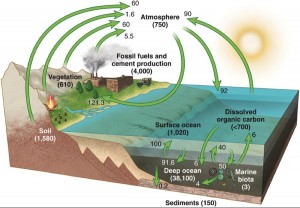
The goal is to model these complex systems at the present time but also into the recent and geologic past and into the future. This gets complicated quickly with all of the factors involved.
Of course, all of the students and post-doc’s were able to take away some amazing new information about unfamiliar analytical techniques or maybe remote sensing or even new knowledge about these popular(?) and infamous(?) Global Climate Models (GCMs). But I think what I took away from this workshop the most was first pointed out by Didier Paillard in the first lecture and then confirmed by many of the other modelers present, especially since I come from a modeling background. Didier really wanted us to understand that it is ok for our models to be wrong, or that is, not represent the data or findings that we want to compare the model too. And, in fact, he expressed to us that we should want our models to be wrong!
Now you are saying, “Hold on there for just one minute! Don’t we need models to be right to be able to understand what happened in the past and also what might happen in the future?” Well, yes this is obviously true. But, to be wrong means that we know how to analyze the output of a model and then adjust the input so that model is more accurate for the next time. Also, being wrong can lead to an amazing new discovery that would have never happened if the model(s) were always right. Some of the most famous discoveries in science (and other fields) happened not because the scientists did the right things, but because they made a mistake and were subsequently smart about it! As Didier called them, “smart mistakes.” What, smart mistakes? Yes, well obviously you can make mistakes while doing anything, but the point is that you can learn from that mistake and not make it again or can continually make the same mistake. Hence, the former is considered a “smart mistake.”
And I think these lessons that we learned in this climate workshop and in general in our studies our especially important as young scientists in crucial fields such as climate change, where I tend to think that some (but not all) of the older generation, especially those outside the technical fields, have not learned these lessons and experienced them at work. Thus, we are trying so very hard to find the perfect solution to the world’s climate problems in one try, that, unfortunately, we do not learn from our mistakes and many times perpetuate them over and over again. But maybe there is hope with our generation that can take these lessons and knowledge about climate change and how it works and use it find sustainable solutions for the future. Who knows! But I do know I am very much looking forward to the next iTECC workshop! Stay up to date with iTECC and what we are doing via our website’s blog and social media pages!


